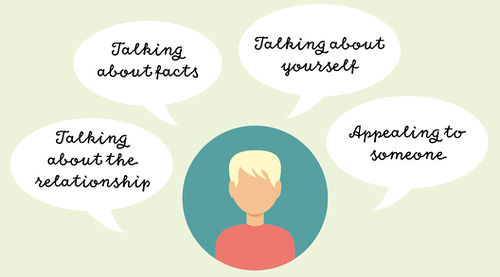The model shows there is no one way of decoding messages. Every message has to be observed individually because the people involved, their relationships to one another, their moods, the situation, and the setting all play important roles. The same sentence spoken by a different person in another situation can mean something completely different.
Many people believe that they predominantly communicate factually, and attribute too large a role to this level: “If I formulate my concerns as accurately as possible, everyone will understand me correctly.” When you communicate with other people, you’re automatically taking a position in response to them. This can often be recognized in non-verbal behavior: uncertainty, speaking nervously or too quickly, tense posture, not making eye contact...
Contents
Content or information
First, there is relayed content; the message contains objective information. No matter what kind of information is at hand, this aspect of the message remains in the foreground. As you're reading this, the foreground of this message is the objective information about the four sides of a message and that this is the initial one.
Relationship
The message also reveals the sender's position towards the receiver, what he or she thinks of him or her. This can be revealed in the choice of words, the tone of voice, and other non-verbal accompanying signals. The receiver has an especially sensitive ear for this facet of the message, because it involves him or her not only as the recipient of communicated information, but as a person treated (or mistreated) in a particular way. In the example of the communication of this theory, the reader develops different feelings based on the way the information is presented, whether it is through a cordial approach, authoritative lecturing, or even a neutral treatment that does not concern his or her personality.
Self-disclosure
A message not only contains objective information about the situation and relational aspects that involve the recipient, it also gives information about the sender who initiated the interaction and encoded the initial information. Without going too deeply into this aspect, from a few words we can conclude that the sender can express him or herself in English, has done some reading, and has some understanding of the Theory of Four Sides of a Message etc.
Appeal
Almost all messages are intended to have some impact on the receiver. Hence, the message also serves to cause the receiver to do, or not to do, and to think or feel certain things. This attempt to influence can be more or less blatant. The appeal aspect has to be separated from the relationship aspect, since the same appeal can be combined with completely different types of information about the relationship. The appeal of this text is to give information about the theory, but also to encourage people to reflecting their communication habits and improving.
Reference
Schulz von Thun, Friedemann : Miteinander reden: Störungen und Klärungen. Psychologie der zwischenmenschlichen Kommunikation. Rowohlt, Reinbek 1981
Nils-Eyk Zimmermann
Editor of Competendo. He writes and works on the topics: active citizenship, civil society, digital transformation, non-formal and lifelong learning, capacity building. Coordinator of European projects, in example DIGIT-AL Digital Transformation in Adult Learning for Active Citizenship, DARE network.
Blogs here: Blog: Civil Resilience.
Email: nils.zimmermann@dare-network.eu





